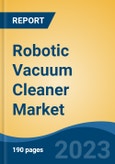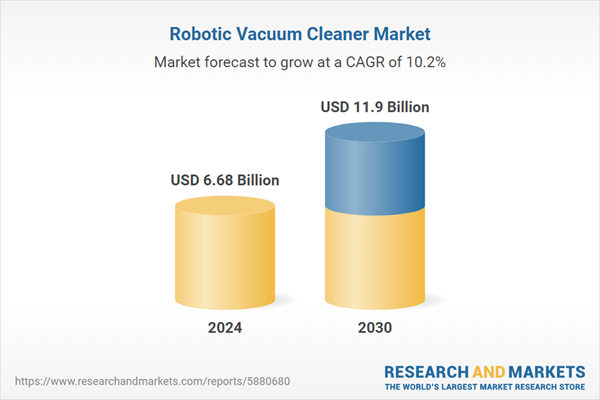Free Webex Call
The Robotic Vacuum Cleaner Market was valued at USD 6.68 Billion in 2024, and is expected to reach USD 11.90 Billion by 2030, rising at a CAGR of 10.16%. The global robotic vacuum cleaner market is experiencing rapid growth, fueled by technological advancements and increasing adoption of smart home technologies. Consumers are seeking automated cleaning solutions that offer convenience, efficiency, and enhanced functionality. Speak directly to the analyst to clarify any post sales queries you may have.
10% Free customizationThis report comes with 10% free customization, enabling you to add data that meets your specific business needs.
Innovations such as artificial intelligence (AI), machine learning, and advanced sensors are improving navigation, obstacle detection, and cleaning efficiency. The growing trend toward smart home ecosystems and rising disposable incomes are further driving demand. Additionally, environmental concerns are encouraging manufacturers to develop energy-efficient and eco-friendly models. The market's expansion is supported by the integration of voice control and mobile app connectivity for seamless user experiences.
Key Market Drivers
Technological Advancements in Robotic Vacuum Cleaners
One of the primary drivers of the global robotic vacuum cleaner market is the rapid advancement in technology. Manufacturers are continuously incorporating innovations such as artificial intelligence (AI), machine learning, and advanced sensor technologies to enhance product functionality. These advancements improve navigation, object detection, and obstacle avoidance, making robotic vacuum cleaners more efficient and user-friendly.The development of sophisticated mapping technologies and laser-guided navigation systems has significantly improved the cleaning coverage and adaptability of robotic vacuums. Additionally, AI-driven software updates enable these devices to learn and adapt to different home layouts over time, ensuring improved performance.
Rising Demand for Convenience and Automated Cleaning Solutions
With increasingly busy lifestyles, consumers are seeking convenient and time-saving solutions for household chores. Robotic vacuum cleaners offer the advantage of automated cleaning, requiring minimal human intervention. Their ability to operate autonomously and efficiently clean various floor types makes them highly attractive to modern consumers. According to a smart home study, 2/3 of homeowners in the United States view smart home devices as essential for their daily lives. This growing sentiment is driving the demand for robotic vacuum cleaners, as more people seek convenience and automation in their homes. The increasing adoption of such devices is expected to significantly boost the market for robotic vacuum cleaners.The hands-free cleaning experience provided by robotic vacuum cleaners is particularly appealing to working professionals, families with children, and pet owners. Moreover, the convenience of scheduling cleaning sessions and the capability to return to their charging stations autonomously further enhances the appeal of these devices. In urban areas where space is limited, the compact and lightweight design of robotic vacuum cleaners provides an added advantage. As these devices become more affordable and accessible, their adoption among households continues to grow.
Increasing Adoption of Smart Home Technologies
The rising popularity of smart home ecosystems is a significant driver of the robotic vacuum cleaner market. Consumers are increasingly investing in smart home appliances to create interconnected and intelligent living spaces.Robotic vacuum cleaners seamlessly integrate with other smart home devices, enhancing their value proposition. For example, users can control their robotic vacuum cleaners through smart speakers, mobile apps, or even smart security systems. The growing adoption of 5G networks and IoT-enabled devices has further accelerated this trend, as these technologies enable real-time communication and improved performance of smart home appliances.
Moreover, governments and utility companies are promoting energy-efficient and connected home solutions to reduce carbon footprints, indirectly supporting the adoption of robotic vacuum cleaners as part of the smart home revolution.
Key Market Challenges
High Initial Costs and Maintenance Expenses
One of the primary challenges in the global robotic vacuum cleaner market is the high cost associated with purchasing and maintaining these devices. Although prices have gradually declined due to technological advancements and increased competition, robotic vacuum cleaners are still significantly more expensive than traditional vacuum cleaners.Moreover, advanced features such as AI-powered navigation, HEPA filtration, and automatic dirt disposal systems often come with premium price tags. Maintenance expenses, including battery replacements, sensor repairs, and filter changes, further add to the overall cost. These factors can deter budget-conscious consumers, particularly in developing economies where purchasing power may be limited. Manufacturers face the challenge of balancing advanced features with affordability to capture a broader market base.
Low Awareness and Adoption in Emerging Markets
The adoption of robotic vacuum cleaners is relatively low in emerging markets compared to developed regions such as North America and Europe. This can be attributed to factors such as limited awareness, lower purchasing power, and a preference for traditional cleaning methods. Cultural factors also play a role, as some consumers in these regions are accustomed to manual cleaning and may view robotic vacuum cleaners as unnecessary luxury items.Moreover, the availability of these devices is limited in certain regions due to inadequate distribution networks and a lack of after-sales support. Language barriers in user interfaces and insufficient local customization further impede adoption. To overcome this challenge, manufacturers need to invest in awareness campaigns, enhance their distribution channels, and offer region-specific features that cater to local preferences.
Key Market Trends
Integration of Artificial Intelligence and Machine Learning
The adoption of artificial intelligence (AI) and machine learning (ML) is revolutionizing the capabilities of robotic vacuum cleaners. These technologies enable devices to learn from their environments, optimize cleaning routes, and improve obstacle detection. AI-powered mapping allows for the creation of dynamic, room-specific cleaning schedules, while object recognition technology ensures that common household items such as cables and pet toys are avoided.Additionally, advanced AI models are improving voice command functionality and real-time decision-making processes, enhancing the overall user experience. As AI technology continues to evolve, robotic vacuum cleaners are becoming smarter, more efficient, and better suited to handle diverse cleaning environments.
Rising Demand for Multi-Functionality
Consumers are increasingly seeking devices that offer multiple functions beyond standard vacuum cleaning. Robotic vacuum cleaners now come with additional features such as mopping, UV sterilization, and self-emptying capabilities. Multi-functional devices not only save time but also eliminate the need for separate cleaning tools, making them more appealing to modern households.The integration of wet-and-dry cleaning functions is particularly gaining traction, as these models can seamlessly switch between vacuuming and mopping tasks. This trend is driving manufacturers to develop versatile products that cater to diverse cleaning requirements, boosting market growth.
Eco-Friendly and Energy-Efficient Designs
With growing environmental concerns, consumers are becoming more conscious of the energy consumption and environmental impact of their appliances. This shift in preference has prompted manufacturers to develop eco-friendly robotic vacuum cleaners that consume less power and use sustainable materials.Innovations such as energy-efficient batteries and optimized motor designs are helping reduce power consumption. Additionally, some models now feature reusable and washable dustbins and filters, reducing the need for disposable components. The emphasis on sustainability is becoming a key factor for market players seeking to differentiate themselves and appeal to eco-conscious consumers.
Segmental Insights
Type Insights
The floor vacuum cleaner segment dominated the global robotic vacuum cleaner market, driven by increasing consumer demand for efficient and automated cleaning solutions. These devices are particularly popular for their ability to navigate and clean various floor types, including hardwood, tiles, and carpets. Advanced features such as smart navigation, obstacle detection, and app-based controls enhance their efficiency and convenience. The segment's growth is further fueled by rising adoption in both residential and commercial spaces. Continuous innovations, including multi-surface cleaning and integration with smart home technologies, are expected to sustain the dominance of floor robotic vacuum cleaners in the market.Regional Insights
The Asia Pacific region dominated the global robotic vacuum cleaner market, driven by rapid urbanization, rising disposable incomes, and increasing adoption of smart home technologies. Countries like China, Japan, and South Korea are key contributors due to their technological advancements and strong manufacturing capabilities. The growing awareness of automated cleaning solutions and busy lifestyles are further fueling demand. Additionally, expanding e-commerce platforms make robotic vacuum cleaners more accessible to consumers across the region. Manufacturers are focusing on innovation and local customization to capture the market's growing potential, solidifying Asia Pacific's position as a leading segment in the global market.Key Market Players
- iRobot Corporation
- Ecovacs Robotics Co., Ltd.
- Xiaomi Corporation
- Beijing Roborock Technology Co., Ltd.
- SharkNinja Operating LLC
- Neato Robotics, Inc.
- Cecotec Innovations SL
- Panasonic Corporation
- Samsung Electronics Co., Ltd.
- Dyson Ltd.
Report Scope:
In this report, the Global Robotic Vacuum Cleaner Market has been segmented into the following categories, in addition to the industry trends which have also been detailed below:Robotic Vacuum Cleaner Market, By Type:
- Floor Vacuum Cleaner
- Pool Vacuum Cleaner
Robotic Vacuum Cleaner Market, By Application:
- Residential
- Commercial
Robotic Vacuum Cleaner Market, By Region:
- North America
- United States
- Canada
- Mexico
- Asia-Pacific
- China
- Japan
- India
- Australia
- South Korea
- Indonesia
- Europe
- France
- United Kingdom
- Italy
- Germany
- Spain
- South America
- Argentina
- Colombia
- Brazil
- Middle East & Africa
- South Africa
- Saudi Arabia
- UAE
- Turkey
Competitive Landscape
Company Profiles: Detailed analysis of the major companies present in the Global Robotic Vacuum Cleaner Market.Available Customizations:
With the given market data, the publisher offers customizations according to a company's specific needs. The following customization options are available for the report.Company Information
- Detailed analysis and profiling of additional market players (up to five).
This product will be delivered within 1-3 business days.
Table of Contents
1. Introduction
2. Research Methodology
3. Executive Summary
4. Voice of Customers
5. Global Robotic Vacuum Cleaner Market Outlook
6. North America Robotic Vacuum Cleaner Market Outlook
7. Asia Pacific Robotic Vacuum Cleaner Market Outlook
8. Europe Robotic Vacuum Cleaner Market Outlook
9. South America Robotic Vacuum Cleaner Market Outlook
10. Middle East & Africa Robotic Vacuum Cleaner Market Outlook
11. Market Dynamics
12. Impact of COVID-19 on Global Robotic Vacuum Cleaner Market
14. Competitive Landscape
15. Strategic Recommendations/Action Plan
Companies Mentioned
- iRobot Corporation
- Ecovacs Robotics Co., Ltd.
- Xiaomi Corporation
- Beijing Roborock Technology Co., Ltd.
- SharkNinja Operating LLC
- Neato Robotics, Inc.
- Cecotec Innovations SL
- Panasonic Corporation
- Samsung Electronics Co., Ltd.
- Dyson Ltd.
Table Information
| Report Attribute | Details |
|---|---|
| No. of Pages | 181 |
| Published | February 2025 |
| Forecast Period | 2024 - 2030 |
| Estimated Market Value ( USD | $ 6.68 Billion |
| Forecasted Market Value ( USD | $ 11.9 Billion |
| Compound Annual Growth Rate | 10.1% |
| Regions Covered | Global |
| No. of Companies Mentioned | 10 |









